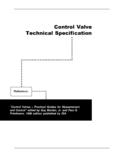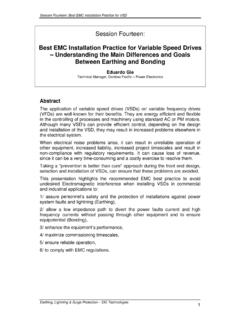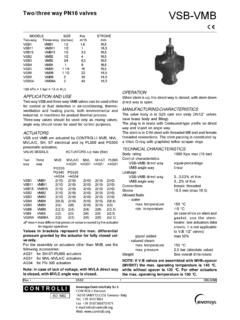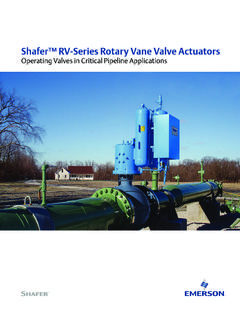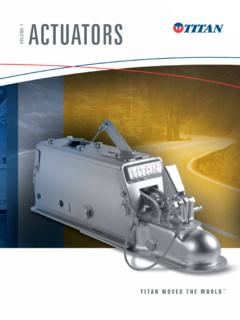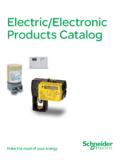Transcription of Part 1 Control Valve Actuator Options - …
1 George Ritz, Contributing EditorThis article is the first in a two-part se-ries examining the state of the art in con- trol Valve actuators and their current ap-plication guidelines in the process indus-tries. Part I deals with the mechanical as-pects of Valve Actuator Options . Part II,in next months issue of Control , willcover the benefits of using the latest gen-eration of smart, digitally controlled the past several years, Valve actuators have re-ceived relatively little attention while process Control specialists concentrated on Control -lers, sensors, and other components of thecontrol loop. This is borne out by theControl Valve Actuator OptionsToday s Actuators Offer Imposed Performance With Lower Life-Cycle Challenge Is Choosing the Right One for the 1unglamorous nickname pig iron as-signed to the Actuator / Control Valve the onset of the smart- Valve genera-tion, it suddenly appears that the controlvalve Actuator may get more respect alongwith its new electronics degree.
2 Today the available Actuator menu in-cludes four basic types of mechanical ac-tuators (Table 1) which recently have beenenhanced with onboard of the improvements available to endusers include a wider source of power op-tions, quicker response, tighter Control ,easier maintenance, improved life cyclecosts, and a host of others. Selecting the proper Actuator for a givenapplication depends heavily on matchingit to the Valve or other driven process Control engineer is well ad-vised to take advantage of vendors expe-rience gained over many years of select-ing the most effective Valve / Actuator pack-age for a wide variety of service require-ments. A good example of this is the recent risein popularity of the pneumatic piston ac-tuator and quarter-turn Valve package offers many advantages (seeTable II) along with excellent Control , com-pact silhouette, easier maintenance, andmost importantly, improved Valve -stememissions checklistA quick review of the Actuator charac-teristics listed in Table I indicates whichactuator type is best suited for a par-ticular application.
3 For example, thespring and diaphragm (S&D) and pneu-Table I. Mechanical Valve Actuator CharacteristicsTYPEPOWERRANGE OFTHRUST ORVALVE TYPESTIFFNESSMATERIALS OFSOURCESERVICESTORQUEAPPLICATIONCONSTRU CTIONCAPABILITIESS pring andAir to 30 psig,Throttling, on-offLight toVertical direct,Low toVarious elastomericdiaphragmspring returngeneral servicemoderaterotary withmoderatediaphragms andlinkageframe materialsPneumaticAir to 50-150 Throttling, on-offModerateVertical direct,ModerateAvailable in CS,SS, Pistonpsig, opposedgeneral serviceto highrotary withto highcorrosion-resistantpistonslinkagemat erialsElectricElectric motorLimited throttlingVery highBest on largerVery highCS,SS, aluminumMotorand gear traingood on-offremote rotaryand epoxy filledOperatedservicevalvescompositesEle ctro-Electric motorGood in throttlingModerateVertical direct.
4 HighAvailable in variousHydraulicand pumpservicesto very highrotary w/materials to suitlinkage, handlesenvironmentdampers wellOELEMENTSFAIL SAFEWEIGHT PERPHYSICALINITIALMAINTENANCEAVAILABLERE LIABILITYACTIONUNIT FORCEENVELOPECOSTCOSTACCESSORIESI nherent due tohigh inRequire high LowLowPositioners, limitExcellent, simple,built-in springlarge sizesverticalswitches,matureclearancehan dwheels,technologytechnologymicroprocess orsRequire springLowModeratelyLow toLow toPositioners, limitExcellent, matureor reserve aircompactmoderatemoderateswitches,techn ologycylindersmicroprocessorsRequireMode rate to highCompactHighLow toLimit Switches,Good dependingstand-bymoderatemicroprocessors , on power source,power sourceremote operatorsmaturepositionerstechnologyRequ ireModerateRequire high HighestHighestPositioners, limitHigher maint-stand-by powerverticalswitchesenance, multiplesource or springclearancemoving partsmatic piston (PP) actuators are well suitedfor low to moderate thrust required bysmall to medium sized valves .
5 This coversabout 80% of process plant applications. Electric motor and electrohydraulicActuators strong points are high thrustfor larger valves where there is noconvenient air supply. This makes themmost appropriate in large utility, pipe line,and remote location services. The lack of inherent fail-safe operationcontinues to limit the application ofelectrically-driven actuators fromcapturing more of the lower-thrust,hazardous-service applications that are soprevalent in process actuators can meet thefail-safe requirement with an added springin one of the pistons, so their use can headvantageous in solving some uniquepositioner applications within the processplant. The key elements to consider whenselecting an Actuator / Control valvecombination include: Type of service-on/off or throttling; Power source-air, electric, or other; Loop stability requirements; Input signal compatibility; Actuator thrust requirements; Size and weight considerations; Safety requirements ( fail-safeoperation, area classification, etc.)
6 ; Operating environment-heat,vibration, corrosion. etc.; Dead band and hysteresis factors;Use of accessories ( , positioners,micro switches, handwheels,microprocessors, etc.); Ease of maintenance; and, Economic factors-first cost,maintenance costs, andlife-cycle costs. The type of service has a direct bearingon the selection of the Actuator for on/offor throttling service. Any of the actuatorstypes listed in Table I are suitable for on/off service. Operating speed, tight shut-off, and fail-safe operation are also vital inthis type of service. Throttling action introduces theaccuracy factor; the Valve must be ableto hold intermediate Control points inresponse to a variable signal. The work-horse in this application for light thrustunits is the S&D Actuator , which may dothe job without a positioner. If highthrust is required, a double-acting PPactuator with a suitable positioner willprobably offer the most reliable andeconomical approach.
7 For high thrust, fail-safe operation-aswell as close Control in a difficultenvironment-the more expensive electro-hydraulic Actuator may be challenging Control applicationrequiring greater loop stability mightwarrant consideration of a smart Actuator with an onboard microcomputer.(These devices and their advantages willbe covered in more detail in the secondarticle of this series.) Size and weight are the maindisadvantages of the S&D Actuator (andto a lesser degree the PP Actuator ) on large-sized valves . If the application area is notrestrictive to a large silhouette, the S&Dor the PP Actuator is probably the way togo. The moderate cost of a supportingstructure along with the higher actuatorcost may still not be great enough to upsetthe economics of the S&D/PP selection.
8 One major area crucial to effective actuatorselection is its ability to over-come stemresonance problems to maintain the processvariable close to the Control point. Factorsaffecting resonance ( Valve hunting) problemsInvolve stiction ( Valve stem friction), Actuator stiffness, stroking speed, plug-head buffeting, hysteresis, and otherfactors. Most of these problem areas,which are inherent in various actuators tosome degree, are handled by effectivelymatching the Actuator with a valvepositioner. The applications engineershould do the best possible job of pickingthe most suitable Actuator for the service-don t unload any inherent actuatorFINAL CONTROLELEMENTS problems onto the positioner as a decision-makingChampion Paper, Inc. has discovered theimportance of integrating a sound actua-tor/ Control Valve unit in the Control loopsat its integrated paper mill in Houston,Texas.
9 Champion s corporate goals of prod-uct improvement, customer satisfaction,and rightsizing led the controls group tothe realization that Control Valve perfor-mance offered the best opportunity forimproved mill performance with the leastcapital expenditure. We found that 80-90% of our controlproblems were in Control Valve perfor-mance, says Control engineer Don Jor-dan. Faulty Control Valve operationcannot be tweaked or adjusted out bythe controller alone. Our approach hasbeen to work with EnTech Control Engi-neering (a controls consultant based inTable II. Valve Actuator Advantages and DisadvantagesADVANTAGESDISADVANTAGESSPRI NG AND DIAPHRAGML owest first costLimited force outputOperating simplicity and reliabilityLarge size and weight per unit forceThrottles well without positionerLow StiffnessInherent fail-safe operationDoes not handle high ambient temperatures wellLow air pressure supplyEasily adjustable to local conditionsFew moving partsEase of maintenanceMost mature technologyPNEUMATIC PISTONHigh force and torque capacityRequires spring or accessories for fail safe operationModerately compact silhouetteMust have positioner to functionLow weight to power ratioHigher first cost than S&D actuatorCan stand high ambient temperaturesRequires high pressure air to operateFast stroking speedGood throttling controlFew Moving partsRelatively high Actuator stiffnessAvailable in)
10 Smart Valve configurationAvailable in corrosion resistant materialsELECTRIC MOTOR DRIVEHigh force outputHigh first costVery high stiffnessNot inherently fail safeCompact silhouetteLimited duty cycle of motor driveSlow stroking speed (if required)Multiple moving partsDoes not require air supply or I/PCorrosion-resistant seals and construction are availableInfrared emote setting unit availableRelatively mature technologyGood on large valves in remote locationsELECTROHYDRAULICHigh force outputHighest first costHigh Actuator stiffnessMultiple moving parts, highest maintenanceExcellent throttling abilityFails safe only with spring or accessoriesFast stroking speedLeast mature Actuator technologyDoes not require air supply or I/PAccepts harsh environments wellSales & Service LocationsCCI AtlantaTel: (770) 965-9870 Fax: (770) 965-9905 CCI BostonTel: (617) 335-1964 Fax: (617) 335-0464 CCI ChicagoTel: (847) 742-6505 Fax: (847) 742-0511 CCI HoustonTel: (281) 492-6904 Fax: (281) 492-6980 CCI China *Tel: 86-10-6501 0350 Fax: 86-10-6501 0286 CCl ChinaTel: 86-21-6485 1331 Fax: 86-21-6485 1328 CCI FranceTel: 33-14-692-2430 Fax: 33-14-692-2359 CCI GermanyTel: 49-521-139510 Fax: 49-521-139554 CCI Hong KongTel: 852-2492-7608 Fax: 852-2498-5878 CCI IndiaTel: 91-33-473-0810 Fax: 91-33-247-1269 CCI IndonesiaTel: 011-62-21-5301307 Fax: 011-62-21-5320369 CCI ItalyTel: 39-383-60-537 Fax: 39-383-60-587 CCI Japan194-2, ShukunoshoIbaraki-City, Osaka 567, JapanTel: 81 726 41 7197 Fax: 81 726 41 7198 This solar powered electrohydraulicValve Actuator develops 4,000-lb.
